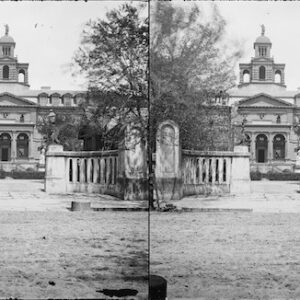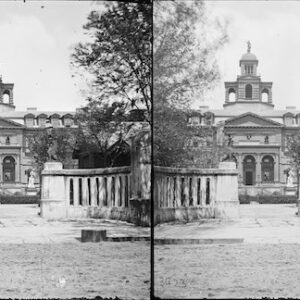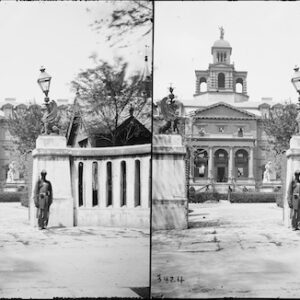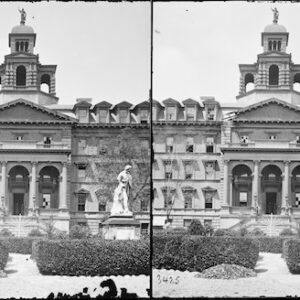Tag: William Pitt the Elder statue (Charleston SC)
 An uncredited stereo card says: …The Statue to be seen on the right of the steps, is that of Sir William Pitt, or Lord Chatham, which possesses considerable interest on account of its revolutionary history as follows: At a meeting of the Commons House of Assembly, in May, 1766, then in session in Charleston, on motion of the Hon. Judge Lowndes, it was resolved “that they would make provision to procure from England a marble statue of the Right Hon. William Pitt, for his disinterested and generous assistance afforded them towards obtaining a repeal of the Stamp Act.” The Assembly voted in the Tax Act of that year, £7,000 for the purpose of carrying out the object of the resolution. Wilton, the King’s Sculptor, was employed to execute the statue. He sent two designs–one for a niche, the other for a separate pedestal. The latter design was adopted. On the morning of the 25th of May, 1770, the statue was landed on the wharf, where it was received by the inhabitants of Charleston, and drawn by themselves to the Arsenal, which occupied a portion of the site of the present Guard House, at the corner of Meeting and Broad streets. On the afternoon of the 5th of July, 1770, it was raised at the intersection of Meeting and Broad streets, nearly the whole of the inhabitants from the City being present, including the Speaker and Members of the House of Commons. After it had been successfully raised, the Speaker of the House of Commons proclaimed aloud amid great cheering, the inscription on the base of the Statue, as follows: “In grateful memory of his service to his country in general, and to America in particular, the Commons House of Assembly of South Carolina unanimously voted this Statue of the Right Honorable William Pitt, Esq., who Time shall sooner destroy this mark of their esteem, than erase from their minds their just sense of his patriotic virtues.” At the conclusions of the Speaker’s proclamation, a salute of twenty-six guns was fired, and The bells of St. Michael’s Church were rung. The ceremonies of the day were closed with a public dinner. During the siege of Charleston by the British, in the Revolutionary War, the right arm of the Statue was shot off by a cannon ball, which has never been replaced. In 1794, the General Assembly of the State granted permission to the City Council to remove the Statue, as it obstructed the free use of Meeting and Broad streets. On the 14th March, 1794, it was removed, and subsequently erected in the Orphan House enclosure, where it yet remains, with its mutilated arm, as an historical memorial of Colonial times. During its removal, the Statue fell to the ground, and the head was broken off.
An uncredited stereo card says: …The Statue to be seen on the right of the steps, is that of Sir William Pitt, or Lord Chatham, which possesses considerable interest on account of its revolutionary history as follows: At a meeting of the Commons House of Assembly, in May, 1766, then in session in Charleston, on motion of the Hon. Judge Lowndes, it was resolved “that they would make provision to procure from England a marble statue of the Right Hon. William Pitt, for his disinterested and generous assistance afforded them towards obtaining a repeal of the Stamp Act.” The Assembly voted in the Tax Act of that year, £7,000 for the purpose of carrying out the object of the resolution. Wilton, the King’s Sculptor, was employed to execute the statue. He sent two designs–one for a niche, the other for a separate pedestal. The latter design was adopted. On the morning of the 25th of May, 1770, the statue was landed on the wharf, where it was received by the inhabitants of Charleston, and drawn by themselves to the Arsenal, which occupied a portion of the site of the present Guard House, at the corner of Meeting and Broad streets. On the afternoon of the 5th of July, 1770, it was raised at the intersection of Meeting and Broad streets, nearly the whole of the inhabitants from the City being present, including the Speaker and Members of the House of Commons. After it had been successfully raised, the Speaker of the House of Commons proclaimed aloud amid great cheering, the inscription on the base of the Statue, as follows: “In grateful memory of his service to his country in general, and to America in particular, the Commons House of Assembly of South Carolina unanimously voted this Statue of the Right Honorable William Pitt, Esq., who Time shall sooner destroy this mark of their esteem, than erase from their minds their just sense of his patriotic virtues.” At the conclusions of the Speaker’s proclamation, a salute of twenty-six guns was fired, and The bells of St. Michael’s Church were rung. The ceremonies of the day were closed with a public dinner. During the siege of Charleston by the British, in the Revolutionary War, the right arm of the Statue was shot off by a cannon ball, which has never been replaced. In 1794, the General Assembly of the State granted permission to the City Council to remove the Statue, as it obstructed the free use of Meeting and Broad streets. On the 14th March, 1794, it was removed, and subsequently erected in the Orphan House enclosure, where it yet remains, with its mutilated arm, as an historical memorial of Colonial times. During its removal, the Statue fell to the ground, and the head was broken off.



